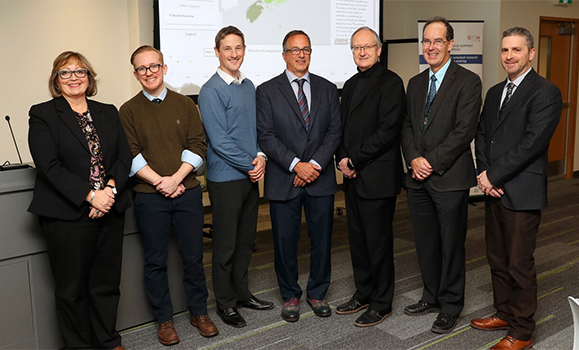Earlier this year, the Maritime Strategy for Patient-Oriented Research (SPOR) SUPPORT Unit — known as MSSU — published the results of a research study led by Dal’s George Kephart of Dal's Department of Community Health and Epidemiology.Â
The study looked at high-cost health care use in Nova Scotia and found that nearly two-thirds of health-care resources are being spent on just 5 per cent of the population — and that these high-cost users are clustered in small areas across the province.
That sort of data is critical in helping health-care stakeholders and decision makers direct resources where they can best make an impact. And now, thanks to another Dal collaboration with MSSU and the Government of Nova Scotia, that data has a whole new look.
The , launched this week at an event in Dal’s Collaborative Health Education Building, is an interactive, web-based mapping tool. Available to the general public, it allows visualization of various measures of health status, health service use and the social determinants of health across the province.
“The availability of this information in a single location, in a user-friendly format, will better enable Nova Scotia’s health-care research stakeholders to understand and respond to the health-care challenges facing the province,” explained Adrian Levy, professor and head of Dal’s Department of Community Health and Epidemiology and principal investigator of the MSSU.
Adrian MacKenzie, senior health policy researcher with MSSU and an adjunct professor at Dal, led attendees at the event through a tour of the atlas. With just a few clicks, the atlas can visualize data ranging from average health-care spending per-person to rates of diseases like cancer and diabetes, cross-tabulated with demographic details such as age and gender.
A new way of looking at health care
The Nova Scotia Health Atlas also represents the launch of a new geography of sorts for organizing health data in the province: “community clusters,” geographic boundaries built around communities and their health-service usage, rather than on existing administrative boundaries (like postal codes). These 55 clusters have been developed through a collaborative research project between MSSU, the Nova Scotia Department of Health and Wellness and the Nova Scotia Health Authority, led by Mikiko Terashima of Dal’s School of Planning.
“We now have a common platform, for the first time in this province, to look at both our administrative information — through the Nova Scotia Health Authority and others — and our research information all in the same way, so we start to really get the story of our communities and our citizens and their health needs,” said Lynn Edwards, senior director, primary health care and chronic disease management with the Nova Scotia Health Authority.
 Mike Reid (left), a second-year master’s student in Community Health and Epidemiology, says the community clusters will be crucial for research such as his, which is studying variation in repeat hospitalization rates across the province.
Mike Reid (left), a second-year master’s student in Community Health and Epidemiology, says the community clusters will be crucial for research such as his, which is studying variation in repeat hospitalization rates across the province.
“Research conducted using these geographies will allow those of us in the research community to drill down into the local conditions that influence the health-care use and outcomes, and share those findings with those who can make a difference in health system design and delivery,” he said.
Several of the speakers at the event credited Dr. Peter Vaughan, deputy minister of the Nova Scotia Department of Health and Wellness, with helping push the Nova Scotia Health Atlas forward. Dr. Vaughan applauded the project as an exciting first step towards a more informed understanding about health care in Nova Scotia — and beyond. (The atlas will be adding data from New Brunswick and Prince Edward Island in the future.)
“This is just the beginning of the power of what we have,” says Dr. Vaughan. “We need it for planning purposes, absolutely, but we also need it in the hands of our colleagues, our clinicians, who can use that data to better understand the people who are in front of them.”
Visit the Nova Scotia Health Atlas online at
 Left to right: Lynn Edwards (Nova Scotia Health Authority); Mike Reid (master's student, Community Health and Epidemiology); Adrian MacKenzie (Senior Health Policy Researcher, MSSU); Adrian Levy (Nominated Principal Investigator, MSSU; Department Head, Community Health and Epidemiology); Peter Vaughan (deputy minister of health and wellness); David Anderson (dean of medicine, HÂţ»); Mark Filiaggi (associate vice-president research, HÂţ»).
Left to right: Lynn Edwards (Nova Scotia Health Authority); Mike Reid (master's student, Community Health and Epidemiology); Adrian MacKenzie (Senior Health Policy Researcher, MSSU); Adrian Levy (Nominated Principal Investigator, MSSU; Department Head, Community Health and Epidemiology); Peter Vaughan (deputy minister of health and wellness); David Anderson (dean of medicine, HÂţ»); Mark Filiaggi (associate vice-president research, HÂţ»).

